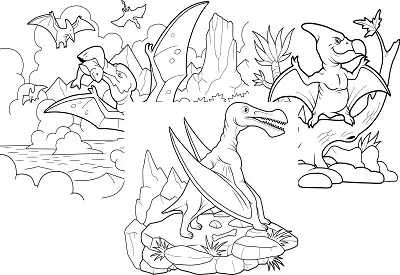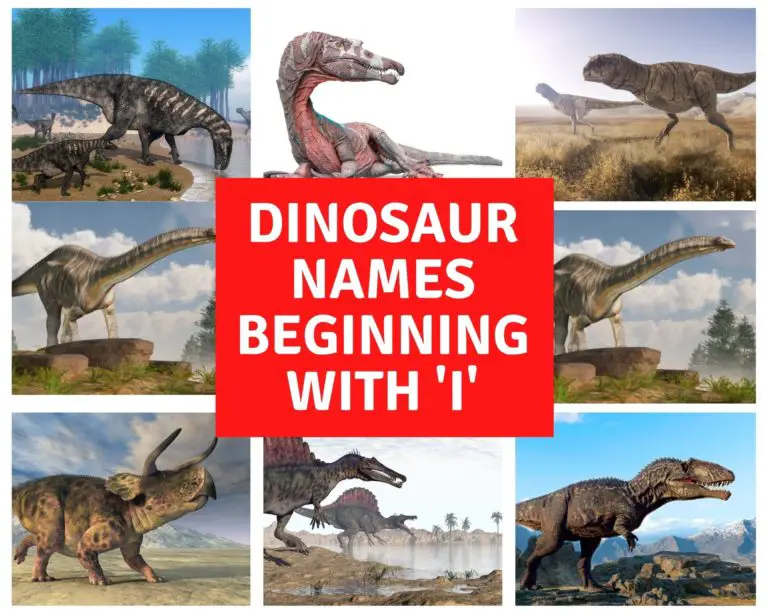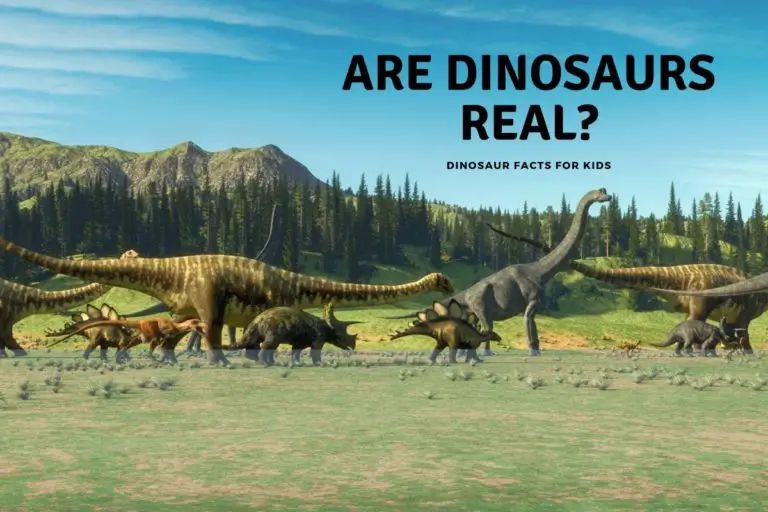Were there Any Flying Dinosaurs? (12 Most Common Flying Reptiles)
Contrary to popular belief, there is not a great deal of evidence to support the existence of fully flying dinosaurs. They are often confused with flying reptiles known as pterodactyls, and officially known as pterosaurs. However this were not classed as dinosaurs, despite living at the same time and ,let’s be honest, looking to most of us just like dinosaurs!
Today, when people speak of flying dinosaurs, they talk about the Pterodactyls and pterosaurs Although the pterosaurs are not dinosaurs, they did live at the same time and in the same area. They even came from the same family a long time before.
So when people ask, “what were the flying dinosaurs?” the real question is, “what were the flying reptiles?” According to Paleontologists, there are about 130 species of pterosaurs or flying reptiles. Below we have 13 of the most common and coolest flying dinosaurs. ( and yes we mean flying prehistoric reptiles!)
- Dimorphodon
- Rhamphorhynchus
- Germanodactylus
- Haopterus
- Quetzalcoatlus
- Archaeopteryx
- Microraptor
- Moganopterus
- Pterodaustro
- Istiodactylus
- Tupandactylus
- Pteranodon
- Sinornithosaurus
if you want to jump ahead to the 13 common flying reptiles, and a couple of contenders for flying dinosaurs you can click here. We also have a pronunciation guide for you as some of these names get quite tricky!
The first pterosaurs fossil was discovered in 1784 in Bavaria, Germany. Many more have been unearthed around the globe since then.
Scientists believe that the pterosaurs co-existed with the dinosaurs during the Triassic period until the end of the Cretaceous period. According to science, the two animals seem to have gone through a convergent evolution where two distantly related animals independently evolve, ending up with similar traits.
This article will discuss the both a little about these pterosaurs and the most common flying dinosaurs…I mean flying reptiles.

What do we really call flying dinosaurs?
It is important to note that there are very few actual dinosaurs that were considered capable of flight and of those none were able to fly like birds can today they were more likely to be gliders from tree to tree, or capable of short flights.
However there were animals alive at the time of the dinosaurs that were flight capable, and could fly for long distances these were called Pterosaurs and although they looked like dinosaurs they were in fact primitive and prehistoric flying reptiles
How to pronounce Pterosaur?
It is actually looks like quite a difficult word to say as it has silent letters, but once you know that it gets easier!
It has only 3 syllables and you say it like this. Teh – Ruh – Sore
Teh – Ruh – Sore
What are the features of Pterosaurs?
Differences between dinosaurs and pterosaurs
One of differences between pterosaurs and dinosaurs were how their legs were positioned on their bodies. In dinosaurs they went straight from their body, underneath. However pterosaurs legs, and limbs were positioned at the side.
What did pterosaurs eat?
it is thought that Pterosaurs ( flying reptiles) were mostly fish or small animal eaters due to the design of their beaks or their teeth. However some smaller pterosaurs would have eaten insects, and some even Fruit. The Pterodaustro which we talk about below.had bristle like teeth and is thought to have eaten like a flamingo sifting water for crustaceans maybe even plankton like a whale!
Others have sharp teeth and would have been able to grab slippery fish from the water, others like the Quetzalcoatlus had sharp beaks they could have used for spearing animals.
Did anything hunt Pterosaurs?
Although they would not have been a great meal for a hungry dinosaur and they were quite light and very bony, they would have been eaten by almost any Carnivorous (meat eating)Dinosaur) that could have grabbed one before it flew away.
As they have been alive all the way through the triassic to the Late Cretaceous they would have seen and lived with all the great Predators, Spinosaurus, T-Rex, Allosaurus and more.
It may be that they could be hunted by other larger pterosaurs as well, either on land or in the air.

Did Pterosaurs have crests?
There is quite a number of these flying dinosaurs that did have crests, some very large and likely very colourful like Tupandactylus. It is also thought that like birds feathers today they used these crests to attract mates or maybe to act as a warning to other pterosaurs or predators to stay away!
What was the biggest Flying reptile?
Although there is a little competition for the title of largest flying reptile, the Quetzalcoatlus is the biggest at the moment. It could have a wingspan up to 52 feet, be up to 500 pounds, and fly for thousands of miles in one go!
We take a look at some of the largest flying pterodactyls here in this article.
it also would have stood as fall as a full grown giraffe when it was on the floor walking. Which is where scientists think it did most of its feeding! We have more information below on this flying giant.
What were the smallest Pterosaurs?
At the other end of the size scale was the Nemicolopterus crypticus which was discovered in China and was alive around 120 million years ago. its name means “Hidden flying forest dweller”. It had a wingspan of only 10 inches ( 25 cms) and would have been very very light!
However it may have been a baby version of a different pterosaur called Sinopterus. We like the idea of tiny Pterosaurs flying around though.
Could any Dinosaurs really Fly?
So we come to the main question, did dinosaurs fly? We know Pterosaurs could, but we also know that pterosaurs were not dinosaurs. so let’s look to see if any dinosaurs could actually fly. and that depends what we think fly means. Let us explain.
Birds today flap their wings and take off, they can glide and of course do so to save energy where they can, but all can flap and fly when needed. ( well not the Ostrich but you know what we mean) This is called powered flight.
So far the most likely candidate for a flying dinosaur, actually powered flight, is the Archeopteryx. Scientist’s put fossils through a machine called a synchrotron that showed that like birds its bones were hollow and light. This means it had the ability for powered flight and would have flown, it is thought, like a Pheasant or a Quail.
This means it would have flown up quickly and then horizontal for a while and then landed and run off as fast as its legs could go! So while it may not have been the prettiest flying animal it certainly would work.
Other dinosaurs that were probably more designed to glide included some other feathered dinosaurs like microraptor and sinornithosaurus both of which we take a look at below.
However, at the moment just Archaeopteryx was the only dinosaur capable of real powered flight.
Could Dinosaurs fly higher than birds?
Although Pterosaurs, flying dinosaurs could fly pretty high, birds have evolved to be true masers of the air. There are numerous bird who are able to fly over 25,000 feet. The Common Crane, the Bar-headed goose and the Whooper Swan included.
The Quetzalcoatlus, the largest flying dinosaur ( Pterosaur) is estimated to be able to fly up to 15,000 feet in recent studies, and at speeds of 80 miles an hour. However the record for the highest flying bird, the Ruppel’s Griffon Vulture is up to 37,000 feet. Which is the same as commercial planes.
However ther eis no doubt the flying dinosaurs were excellent flyers, not in the same class as modern day birds, but considering they were in some cases 500 lbs in weight makes them flying at 15000 feet simply incredible.
Of course there are so many species of birds that some flying dinosaurs ( pterosaurs) certainly did fly higher than birds. Some modern day birds only fly at low levels, pheasants quails etc, and pterosaurs could have certainly flown higher. However at the top end of the scale Birds certainly could fly higher.
How many different Flying Dinosaurs were there?
There are currently over 250 species and Genus of Pterosaur identified by paleontologists and you can check out a full list on wiki here, and more details about each and every one of them here on our page (we will split it in to A- Z of Pterosaurs to make it easier to Navigate)
They came in all shapes and sizes and although some were more famous, to us at least, than others
What is a Pterodactyl?
How to pronounce: Teh – Ruh – Dak – Till
For many years, including when i was at school, all flying dinosaurs were called Pterodactyls no matter what they looked like. However that is not really the name of the flying reptile but was a family group of flying reptiles. The main group was called pterosaurs, and there were over 100 different ones.
Below we check out 13 of the more famous and more common flying dinosaurs and Pterosaurs.
Our Pterosaur and Flying Dinosaur Coloring Pages for download here. ( and more)
13 Common Flying Dinosaurs (Pterosaurs and more)
1. Dimorphodon
How to pronounce: Dih – Morf – uh – Don
The dimorphodon is a flying reptile that lived during the early Jurassic period, and Richard Owen first discovered it in 1859 in England. It is easy to see why they were thought of as a flying dinosaurs.
However recent studies have suggested it may have been a really poor at flying and could have only fluttered around or maybe flown from tree to tree rather than swoop through the skies like other flying dinosaurs (pterosaurs)

This reptile had wide-toothed jaws, a short neck, and a long thin tail with diamond-shaped flap skin at the end. They also had large heads that scientists believe were used to impress their female partners during courtship.
The dimorphodon were clumsy flyers because their legs stretched out the side of their bodies and their heads were over sized. Due to the nature of their legs, scientists had concluded that dimorphodons would hang from trees and cliffs when they were not flying. Like a huge bat from nightmares!
When flying it is thought it would be quite chaotic and really mainly used to get away from a predator.
Table 1: Dimorphodon Quick Facts
| Dimorphodon Facts | Statistics |
| Name Meaning | “two form mouth” |
| Wingspan | 4.6 ft (1.45 meter) Wingspan |
| When Lived | Early Jurassic – 195-190 million years ago. |
| Food Eaten | Insects and small animals |
| Weight | 4 lbs (2kg) |
| Length | 3ft (1 meter) long |
2. Rhamphorhynchus
How to pronounce: Ram – For – Ren – kus
The Rhamphorhynchus is a common species that lived during the Late Jurassic era.
Like dimorphodon, this flying reptile also had a diamond-shaped flap skin at the end of its tail. It is a carnivorous flying reptile with narrow jaws and sharp teeth that protrude outward making it suited for eating fish.
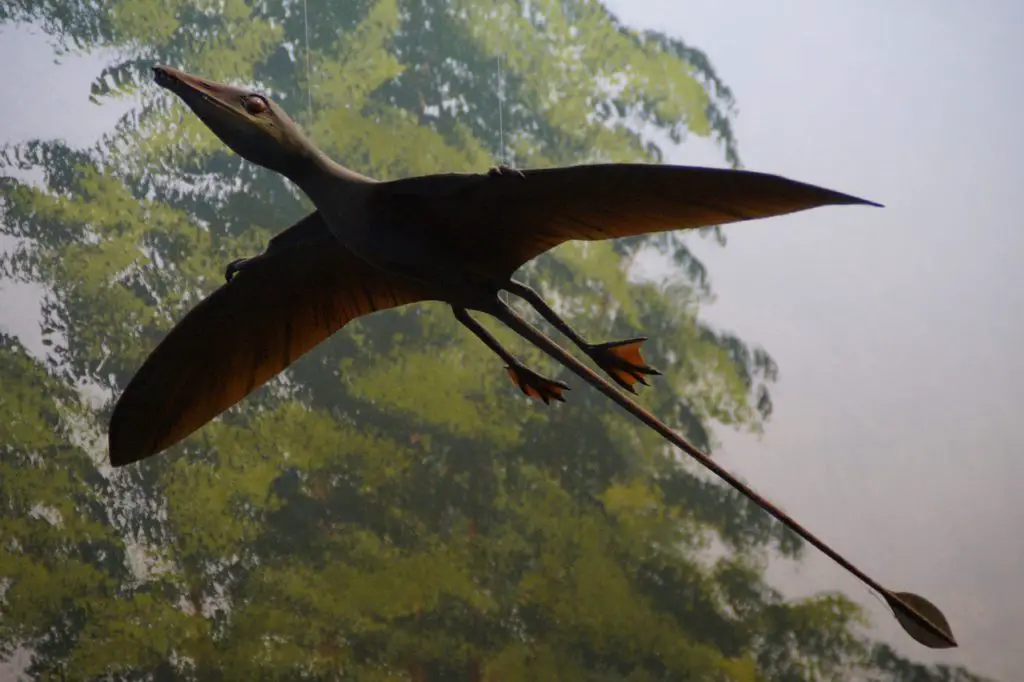
To help with stability while flying, the Rhamphorhynchus also had large light wings making them excellent flyers. On the ground, they were easy prey because they had tiny legs making them poor runners.
However it is thought that it, like seabirds today, would have been able to swim and take off from the water. This may be one of the reasons it is so commonly found as it would have been fossilized in the water quite often.
Table 2: Rhamphorhynchus Quick Facts
| Rhamphorhynchus Quick Facts | Statistics |
| Name Meaning | “Beak Snout” |
| Wingspan | 5.9 ft (1.80 meter) Wingspan |
| When Lived | Late Jurassic – 150 million years ago. |
| Food Eaten | Fish |
| Weight | 3 lbs (1.5kg) (maybe a large fossil found) |
| Length | 4.1 ft (1.26 meters) long |
3. Germanodactylus
How to pronounce: Jerr – Man – oh – Dak – tuh – lus
Germanodactylus is a german name meaning German finger. This flying reptile was first discovered in Germany, hence the name Germanodactylus.
This species is well known because of its head crest, which contained a Keratin protein, enabling the reptile to change its crest color. (maybe!)
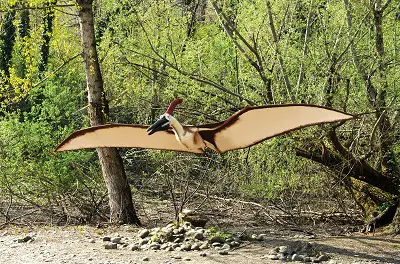
A color-changing dinosaur!
The ability to color change was beneficial during mating season as the Germanodactylus would stand out against its peers.
The Germanodactylus had a wingspan of about three and a half feet and was the same size as a raven. It likely used those sharp teeth to catch and eat fish.
Table 3: Germanodactylus Quick Facts
| Germanodactylus Quick Facts | Statistics |
| Name Meaning | “German Finger” |
| Wingspan | 3.2 ft (1 meter) Wingspan |
| When Lived | Late Jurassic – 150 million years ago. |
| Food Eaten | Fish |
| Weight | 2 lbs (1kg) (maybe a large fossil found) |
| Length | 4ft (1.20 meters) long |
4. Haopterus
How to pronounce: How-op-teh-russ
The haopterus is one of the flying reptiles found in China. The reptile was named after a Chinese professor, Hao Ying Chun, and the Latin word for wing pteron. The haopterus lived during the late Cretaceous period.

These flying reptiles were piscivores meaning they were carnivores who preferred fish as their main meal. The haopterus had a wingspan of about 4-5 feet, enabling them to fly long distances at high elevations.
Scientists believe that the haopterus were quadrupedal (using all 4 feet to walk or run) on land because they had slender hind feet.
Table 4: Haopterus Quick Facts
| Haopterus Quick Facts | Statistics |
| Name Meaning | “Slender built” |
| Wingspan | 4.4 ft (1.35 meter) Wingspan |
| When Lived | Early Cretaceous – 124 million years ago. |
| Food Eaten | Fish |
| Weight | 2 lbs (1kg) (maybe a large fossil found) |
| Length | 4ft (1.20 meters) long |
5. Quetzalcoatlus
How to Pronounce: Kwet – Zul – Coh – At – Lus
The quetzalcoatlus was discovered in North America and is believed to be the largest flying creature on the planet.
Why?
Because they had a wingspan of a whopping 52 feet!
These majestic creatures lived during the late Cretaceous period.
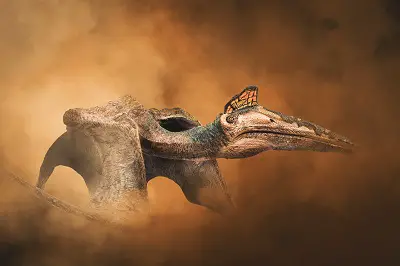
You would think that having large wings would make them slow flyers because of the weight. However, scientists say that the quetzalcoatlus only weighed about 100 kilograms, making them excellent long-distance flyers. They had long necks, which came in handy because they were scavengers.
We have a whole page on Quetzalcoatlus on the link above to check out when you have time.
Table 5: Quetzalcoatlus Quick Facts
| Quetzalcoatlus Quick Facts | Statistics |
| Name Meaning | “Feathered serpent god” |
| Wingspan | 52 ft (16 meter) Wingspan |
| When Lived | Late Cretaceous – 68 million years ago. |
| Food Eaten | carnivore |
| Weight | 450-55-0 lbs (200-250 kg) |
| Length | 34ft (10meters) long |
6. Archaeopteryx
How to pronounce: arr – key – op – tuh – ricks
The archaeopteryx was first thought of as one of the oldest known birds that lived during the Late Jurassic era. This ancient bird like dinosaur was believed to be the link between birds and feathered or non-avian dinosaurs because they share some physical features like:
- Flight
- Feathered tails and bodies
- Sharp claws
However despite these similarities it was most certainly a dinosaur. The archaeopteryx weighed about one kilogram and had the same size as a raven. It would have eaten insects and small animals.

Because the bird lived in southern Germany during the Jurassic period, it also has a German name, Urvogel, which means first bird.
Table 6: Archaeopteryx Quick Facts
| Archaeopteryx Quick Facts | Statistics |
| Name Meaning | “old wing” |
| Wingspan | 3 ft (1 meter) Wingspan |
| When Lived | Late jurassic- 150 million years ago. |
| Food Eaten | insects |
| Weight | 2 lbs (1kg) |
| Length | 20 inches (half a meter) long |
7. Microraptor
How to pronounce: Mike – Roh – Rap – tuh
The Microraptor is also known as the four-winged dinosaur and its small size allowed it to fly, in a fashion, through the forest. It is thought to be more of a glider than a power flier but it was still a skill than not many other dinosaurs possessed and certainly puts it on a list of flying dinosaurs!
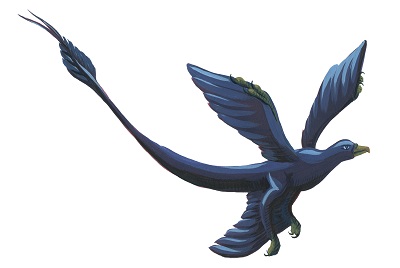
The Microraptor was a small feathered dinosaur-like creature with wings on its front and back limbs weighing between one and five pounds. Scientists are not sure whether the Microraptor was a glider or a flier, but it was going to be a clumsy runner because of the back wings.
Scientists use this dino-bird’s physical appearance to support the theory that the Microraptor would glide or fly short distances to pursue its prey and avoid predators
Table 7: Microraptor Quick Facts
| Microraptor Quick Facts | Statistics |
| Name Meaning | “small thief” |
| Wingspan | 3 ft (1 meter) Wingspan |
| When Lived | Early Cretaceous- 120 million years ago. |
| Food Eaten | insects / fish / small animals |
| Weight | 2.2 lbs (1kg) |
| Length | 2.5 – 3.9 ft (77 cm – 1.2 meters ) long |
8. Moganopterus
How to Pronounce: Mong – nop – tuh – rus
The moganopterus was discovered in China and is believed to have lived during the early Cretaceous period. It is one species with the longest skull measuring about 95 centimeters with 62 teeth.
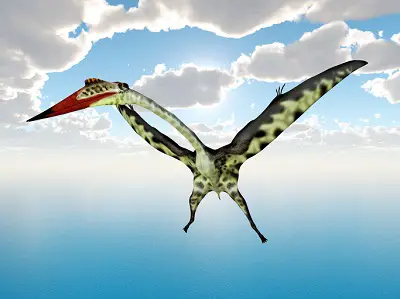
Scientists believe that the Moganopterus were piscivores (a fish-eating animal) because they lived in marine habitats. They also had a thin body with a long neck and wings. In facts even though it had a long head it could be very short! sometimes only 9 cm tall!
That is why it got its name as its mouth looked like two thin swords!
Table 8: Moganopterus Quick Facts
| Moganopterus Quick Facts | Statistics |
| Name Meaning | named after a pair of sword makers. ( Mo Je and Gan Jiang) |
| Wingspan | 23 ft (7 meter) Wingspan (10 feet or 3.5 meters in 2022) |
| When Lived | Early Cretaceous- 124 million years ago. |
| Food Eaten | fish / small animals – sift feeding |
| Weight | 70-130lbs (35-60kg) |
| Length | 19 feet (6 meters) long |
9. Pterodaustro
How to Pronounce: Tair – Roh – Doss – Trow
The pterodaustro is a flying reptile that lived in South America during the early Cretaceous period. The first fossil was unearthed in 1970, and 2 specimens of the species have been found so far.
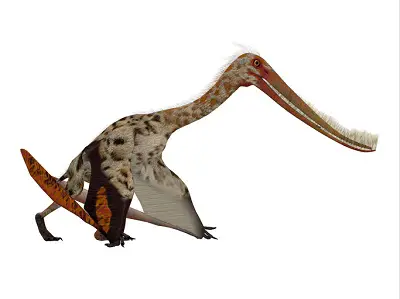
The pterodaustro was a piscivore that lived in a marine environment and mainly ate fish, plankton and crustaceans As it had over 100 bristle like teeth, kinda like a whale! . It had large eye sockets, a long skull, and small bristle like teeth, it may have even been pink like a flamingo due to how and what it ate!
Table 9: Pterodaustro Quick Facts
| Pterodaustro Quick Facts | Statistics |
| Name Meaning | “wing from the south” |
| Wingspan | 8.2 ft (2.5 meters) Wingspan |
| When Lived | Early Cretaceous- 105 million years ago. |
| Food Eaten | fish / small animals / plankton / Crustaceans – sift feeding like a flamingo |
| Weight | 50-100lbs our estimate |
| Length | 7 feet (2.3 meters) long |
10. Istiodactylus
How to pronounce: Ist – Toe – Dak – Till – Us
The Istiodactylus was discovered in 1887- quite a while ago! on the Isle of wight.
This flying reptile lived around Europe during the early Cretaceous period. Scientists have found six species of this pterosaur since it was first discovered.
The Istiodactylus had a shorter skull with 48 interlocked teeth and lived in marine environments. It is also known as the duck-billed dinosaur because its mouth was shaped like a beak, meaning it could easily slice its prey. These teeth were suited to a scavenger.
Table 10: Istiodactylus Quick Facts
| Istiodactylus Quick Facts | Statistics |
| Name Meaning | “sail finger” |
| Wingspan | 14-16ft (4-5 meters) Wingspan |
| When Lived | Early Cretaceous- 125-120 million years ago. |
| Food Eaten | fish / scavenger / meat |
| Weight | 50-100lbs our estimate |
| Length | 6 feet (1.8 meters) long |
11. Tupandactylus
How to Pronounce: Two – Pan – Dak – till – Us
The tupandactylus is a reclassification of the tapejara species. which was a scary looking flying dinosaur.
This flying reptile was first discovered in Brazil and lived during the early cretaceous period. They had a really huge head crest and a small beak with Keratin, and a skull with bony extensions at the back.
the picture below is not exactly correct, as the crest and jaw were even bigger!

Their body was covered with pyconfibers. This creature lived among the arthudactylus and brasileodactylus in a lagoon environment, and their main diet consisted of fruits and flowering plants.
Table 11: Tupandactylus Quick Facts
| Tupandactylus Quick Facts | Statistics |
| Name Meaning | “Tupan Finger” |
| Wingspan | 10- 13ft (3-4 meters) Wingspan |
| When Lived | Early Cretaceous- 112 million years ago. |
| Food Eaten | possibly fruit and plants |
| Weight | 40-100lbs our estimate |
| Length | 5 feet (1.5 meters) long |
12. Pteranodon
How to Pronounce: Tair – Ran – oh – Don
Pteranodon are the most commonly found fossils of any flying dinosaur There have been around 1,200 fossils found so far. Lots of these were very preserved. It was a large pterosaur and its wing span was an average of over 18 feet. Large Pteranodon wongs could be over 20 feet!
it name means toothless wing, and unlike earlier flying reptiles it had no teeth in that long beak. it would have used that beak to swoop down and grab fish. It was thought to be a very good flier and used wind and air currents to fly like sea birds today.
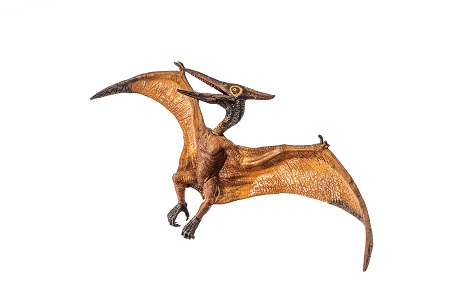
It had quite a big crest which has been suggested to be both used to attract mates and to act as a balance to that powerful and long beak.
Table 12: Pteranodon Quick Facts
| Pteranodon Quick Facts | Statistics |
| Name Meaning | “Toothless Wing” |
| Wingspan | 18ft (5.6 meters) Wingspan |
| When Lived | Late Cretaceous- 86 -84 million years ago. |
| Food Eaten | Mostly Fish |
| Weight | up to 440 lbs |
| Length | 6 feet (1.8 meters) long |
13. Sinornithosaurus
How to pronounce: Sign – On – ith -Oh – Sore – Rus
Sinornithosaurus was a contender for the title of real flying dinosaur. It had both wings, and unlike pterosaurs they were covered with feathers. it was quite small, and would have been about 1 meter – 3 feet long and weigh about 3kg.
Although it had wings, was light and had feathers it wa thought it would not have been fully suited to flying. it would have been similar to Microraptor and climbed up trees to glide down. It had longer legs so would have been faster on the ground.

There was also studies that suggested that sinornithosaurus might have been a poisonous dinosaur as well, though this is not accepted by the majority it does add a scary aspect to their flying dinosaur and was enough to put it on our list of the most Scary dinosaurs!
Table 13: Sinornithosaurus Quick Facts
| Sinornithosaurus Quick Facts | Statistics |
| Name Meaning | “Chinese Bird Lizard” |
| Wingspan | 3 ft (1 meters) Wingspan |
| When Lived | Early Cretaceous- 124-122 million years ago. |
| Food Eaten | Meat, insects |
| Weight | 6 lbs (3kg) |
| Length | 3 feet (0.9 meters) long |
Conclusion
As you can see even though there were not really any flying dinosaurs as we think of birds flying, there were a few that could fly like the sinornithosaurus and the archaeopteryx. However if we stretch the definition of dinosaur a little ( sorry scientists) and include the Pterosaurs and Flying reptiles then there were over 100 different species !
Some were huge like Quetzalcoatlus and others were tiny but all could fly, more effectively than even the best of the flying dinosaurs.
We hope you have learnt something new about these flying dinosaurs and their Pterosaur cousins and don’t forget to check out the other dinosaur resources we have on the site including coloring , facts sheets, worksheets and more!
References
- https://www.bbc.com/news/science-environment-43386262#:~:text=Archaeopteryx%20lived%20about%20150%20million,dinosaurian%20flight%20evolved%20even%20earlier.
- https://www.osc.org/are-pterodactyls-dinosaurs-learn-more-about-these-prehistoric-predators/#:~:text=Because%20they%20flew%20and%20their,went%20extinct%20along%20with%20dinosaurs.
- https://en.wikipedia.org/wiki/Dimorphodon#:~:text=In%20life%2C%20Dimorphodon%20probably%20relied,air%20as%20a%20last%20resort.
Hi, I am Roy Ford a General Studies and English Teacher who has taught all over the world. What started as a fossil collection became a great way to teach, motivate and inspire students of all ages and all over the world about dinosaurs and from that and children’s love of dinosaurs came the site dinosaur facts for kids, a resource for all ages.

